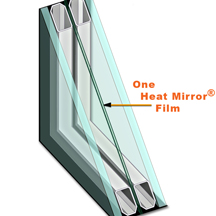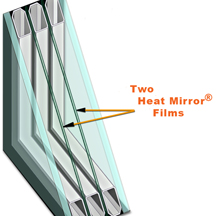Energy Efficiency: Window & Wall Ratings
The big secret regarding energy efficiency in healthcare facilities is window glass, which compared to insulated walls and ceilings, is a terrible energy loser. While we expect that energy-conserving walls and ceilings will dramatically insulate against heat loss and block direct solar radiation, knowledgeable facility managers and project developers anticipate far less in the way of energy conservation from even the most energy-efficient windows. If we are talking about residential properties, whilst this is still an issue, there are such measures that can be taken to improve heat loss such as energy efficient window coverings for one example. While this is a perfectly viable solution for the home, not so much for a healthcare facility.
The numbers speak for themselves. Walls with an insulation performance value of R-19 are considered to be the norm (R means resistance to heat flow the higher the number the better the insulation performance). On the other hand, windows with low emissivity (low-e) coated glass and inert gas fill that meet the coveted Energy Star designation, and whose insulation performance tops out at R-4, are celebrated by architects, contractors and building managers. These knowledgeable observers rightfully see such defacto energy-conserving windows as a substantial improvement over conventional insulating glass with insulation performance of R-2.
But why do we expect our buildings to contain R-19 insulated walls, while at the same time, be willing to accept R-4 windows? Such an energy conservation double standard exists because it is easier to be a wall than a window. Walls only have to insulate well. A window must do a lot more.

Windows (specifically window glass) must be transparent and colorless, transmit natural daylight, reflect unwanted solar energy, decrease ultraviolet radiation that causes fading of building components and furnishings, reduce sound transmission, and of course, insulate against heat loss. In addition, many windows must also open to provide ventilation and egress in emergency situations. Compared to walls, a window must simultaneously perform numerous functions, many of which are highly sophisticated.
If the year were 1960 instead of 2010 perhaps we could maintain one energy conservation standard for walls and ceilings and another less demanding standard for windows and glass. But we can no longer afford to do so, and home and business owners are now searching for ways to save energy. Some are even exploring other areas of the home to make it more efficient such as the roof; using methods such as spray foam roofing residential in a bid to reduce energy bills. This is just one of the areas that are being explored. You can learn more here. Despite heavily insulated walls and ceilings and the popularity of Energy Star designated windows, 25 to 35 percent of the energy used in homes and buildings is wasted due to inefficient glass. So, it should come as no surprise that glass is responsible for more than 10 percent of the total carbon emissions in the United States annually and is a major contributor to global warming. In addition, inefficient windows and glass cause unhappy and uncomfortable building occupants, who are often too cold in winter, too hot in summer, and paying more than they should in heating and cooling costs year-round.

One might think the easiest solution for building managers would be to board-up many existing windows. While such a drastic move might save some energy, it would negate the increasingly recognized benefits of day lighting, the ability to transmit natural light into healthcare buildings through existing openings in walls and ceilings. The benefits of day lighting include:
-Reduced use of artificial illumination
-Reduced sickness and attrition on the part of medical workers
-Reduced recovery times on the part of healthcare facility patients
-Increased winter time passive solar heating on south facing glass
-Improved tenant retention and acquisition in medical office buildings
Since most existing window openings in typical medical facilities can with only minor modifications take advantage of day lighting, there is a big incentive to make those window openings perform better, not reduce their size and number.

Since glass is the heart of a window, heres what building managers need to know about glass options:
Single-pane glass may keep out the weather, but it does little to insulate against heat loss or reflect the suns heat that can cause overheating. In most locations, single-pane glass is not code compliant.
Insulating glass (two panes separated by a sealed air space) with a solar heat-reflective coating is appropriate for buildings concerned with staying cool in summer. The air space inside the sealed glass enhances insulation and the coating reflects the suns heat to prevent over-heating.
Insulating glass with dual heat-reflective coatings, that simultaneously reflect heat from the sun and also reflect ambient heat both inside and outside, combined with inert gas fill (such as argon or krypton) is even more effective in saving energy and increasing occupant comfort.
Many might think this is where the story ends. However, recent and impending revisions to the Department of Energys Energy Star window performance standards will require windows that qualify for the coveted Energy Star designation to provide increased energy efficiency.
Glass available today that will meet the new and forthcoming Energy Star window performance standards include:
Triple pane insulating glass consisting of three panes of glass and two heat reflective coatings. The good news is that adding a third pane of coated glass improves insulating glass performance. The bad news is that triple pane glass is 50 percent heavier than dual-pane insulating glass, requiring stronger window framing, more difficult installation and handling of large units, and increasing cost accordingly. However triple pane windows are an extremely popular choice in todays society.
Suspended film insulating glass containing one or more transparent, heat reflective films suspended inside the air space. Because such films are practically weightless, up to three films can be used to create up to four insulating cavities that dramatically increase insulation performance while reflecting unwanted solar heat. Such super glass can achieve a center of glass insulation value of up to R-20, comparable to that of an insulated wall.
Clearly, the advent of new high performance glass technologies for standard window and curtain wall applications has heralded the end of an energy efficiency double standard for walls and windows.
Bruce Lang is Vice President of Marketing & Business Development at Southwall Technologies, Inc., in Palo Alto, CA. Southwall’s Heat Mirror suspended film insulating glass has been selected to be retrofitted into all 6,500 windows in New Yorks Empire State Building as a leading component of a major energy upgrade.
1
